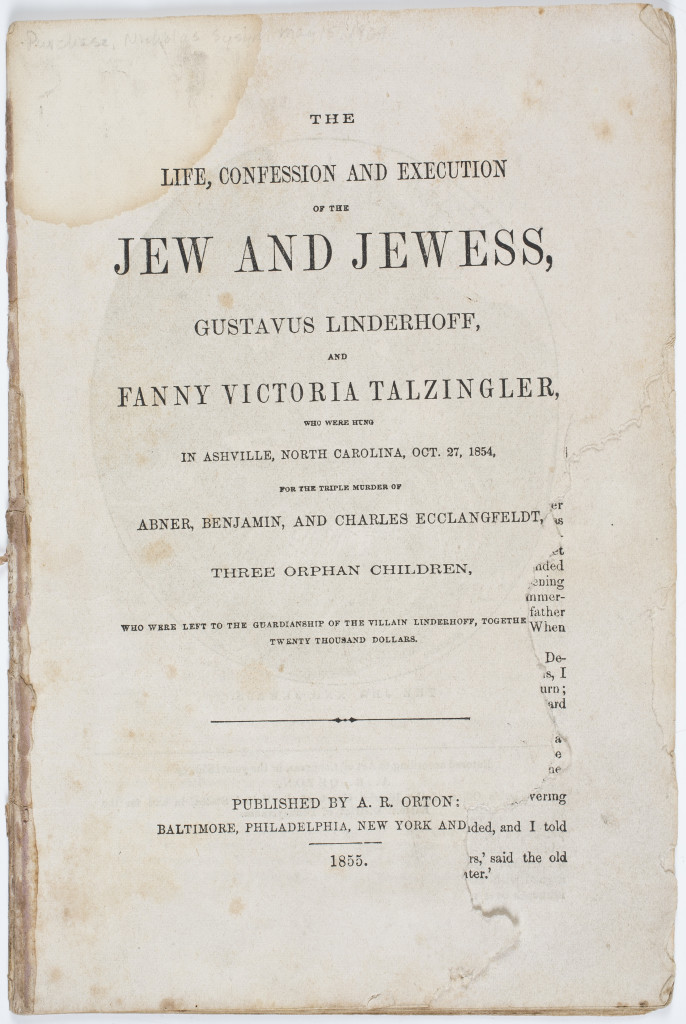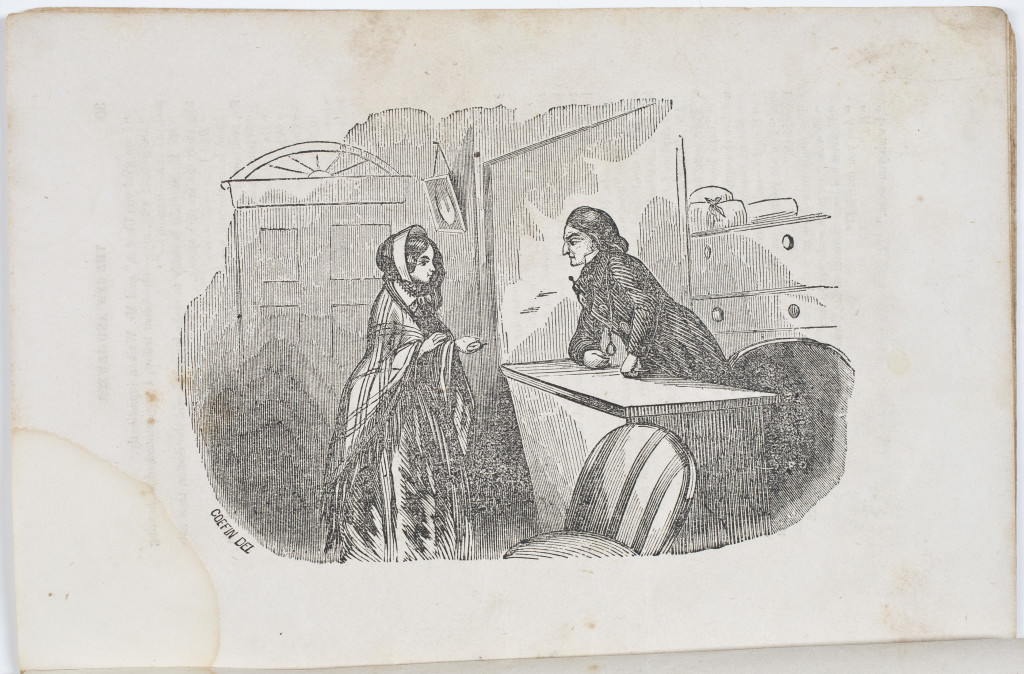Susanna Sigler is currently a summer page at AAS. She is a junior at UMass Amherst majoring in history and minoring in Judaic studies. The opportunity to work at AAS for the summer appealed to her not just as a history major, but as a general lover of history and books, to be a part of the workings of a major research library/archives.
While doing a catalog search for possible blog post topics, I looked up broad subjects of interest to me—towns in Massachusetts, New York, and Pennsylvania where my family has roots, as well as topics like Judaism and Jewish life in America. As I scrolled through the search results for “Jewish” in the AAS catalog (not a very specific search term, I know), most items did not seem particularly out of the ordinary—records of old synagogues, more current histories, and—most prolifically—Christian evangelical materials.
However, about halfway through the list, the phrase “Asheville North Carolina” popped out to me. My family is going to be passing through there this summer on the way to Georgia for a summer road trip. I looked at the rest of the title. “The life, confession, and execution of the Jew and Jewess, Gustavus Linderhoff and Fanny Victoria Talzingler who were hanged in Asheville, North Carolina, Oct. 27, 1854, for the triple murder of Abner, Benjamin, and Charles Ecclangfeldt, orphan children, who were left to the guardianship of the villain Linderhoff, together with twenty thousand dollars.” Wow. Okay then. No spoiler warnings here, huh? Even by nineteenth-century standards, this title was long and sensationalistic.
My first thought, after the initial double-take, was: “wait, how come I’ve never heard of this before?!” I did know, though, that if this execution had really taken place, the crime allegedly committed by Gustavus and Fanny probably hadn’t. And I had a pretty good guess as to what Fanny and Gustavus’s execution would look like. This country is no stranger to the barbarous practice of lynching—extrajudicial murder by mob, often by hanging—which occurred as part of a campaign of terror against African Americans in the South for many decades following the Civil War. The lynching of Jews was rare, despite rampant, violent, Southern anti-Semitism, but it did happen. The most notable case occurred in 1915 with the hanging of Leo Frank, a factory superintendent accused of the murder of a young female employee. With this knowledge and these assumptions floating around in my head, I honestly wasn’t quite sure of what I would really see with this pamphlet. What would prove to be the truth?
When I actually got my hands on the material though, and began to do a little research, it became rapidly clear that the entire series of events—premeditation, triple murder, execution—had been completely made up. Flipping quickly through, one interesting thing stood out to me—the story quotes the Shakespeare play Macbeth throughout. The pamphlet proves itself to be in essence an anti-Semitic retelling of the Shakespearean tale.
Sensationalist pamphlets like this one, which was published by A. R. Orton in Baltimore in 1855, were the forerunners of the immensely popular dime novel. The two categories overlapped a bit during the the mid-nineteenth century. Both the pamphlets and dime novels shared low prices appealing to the masses, as well as a particularly melodramatic sense of story that capitalized on the prejudices of the time. More specifically, many dime novels were similar to Gustavus and Fanny in that they contained grossly anti-Semitic portrayals of characters.
Orton, along with a publisher named E. E. Barclay, were the two main publishers of these pulp fiction pamphlets. Little is known about them; any ideas about what their motives were for publishing these pamphlets, or about their readership, can only be speculative. Since these pamphlets were sold cheaply, often with several bound together, and judging by the popularity of the later dime novels, I would guess that the pulp pamphlets also enjoyed at least a considerable fraction of the dime novels’ popularity.
 The pamphlet’s title manages to squeeze in an impressive number of anti-Semitic tropes and stereotypes in its four lines. “The Jew and Jewess” are the terms used to refer to its two subjects. Mere tone can change the word “Jew” into an epithet, combined with the anti-Semitic, misogynistic term “Jewess.” Gustavus is drawn, both in the text and in the illustrations that accompany it, as dark, smart, and cunning. He is a pawnbroker, one who started out a new life after running away from his apprenticeship with the money he felt he was due. Fanny, his wife, is equally deceitful—they meet when she comes into his shop attempting to pawn stolen jewelry. After his converted Christian cousin, a Mr. Ecclangfeldt, passes away, Gustavus becomes the guardian of Ecclangfeldt’s three children, Abner, Benjamin, and Charles.
The pamphlet’s title manages to squeeze in an impressive number of anti-Semitic tropes and stereotypes in its four lines. “The Jew and Jewess” are the terms used to refer to its two subjects. Mere tone can change the word “Jew” into an epithet, combined with the anti-Semitic, misogynistic term “Jewess.” Gustavus is drawn, both in the text and in the illustrations that accompany it, as dark, smart, and cunning. He is a pawnbroker, one who started out a new life after running away from his apprenticeship with the money he felt he was due. Fanny, his wife, is equally deceitful—they meet when she comes into his shop attempting to pawn stolen jewelry. After his converted Christian cousin, a Mr. Ecclangfeldt, passes away, Gustavus becomes the guardian of Ecclangfeldt’s three children, Abner, Benjamin, and Charles.
Just as in Macbeth, it is the wife who becomes the driving force of the story’s evil. Fanny is the one who pressures Gustavus into murdering the children, and she herself is the one who ends up carrying out the deed against her husband’s squeamishness. In doing so, the story uses the plot of Macbeth to accommodate stereotypes that are not just anti-Semitic but a particularly misogynistic strain of that prejudice. Fanny’s plan of murder, one that will provide them with the orphans’ $20,000, invokes one of the oldest anti-Semitic stereotypes, that of the greedy Jew. So greedy, in fact, that the murdering of children becomes an obstacle easily conquered. Fanny is portrayed in the way that Jewish women have been characterized for centuries—scheming, witchy, pushy, and overbearing. And in this characterization Gustavus is further stereotyped in the way that Jewish men have been characterized—weak-willed, emasculated, and beholden to their domineering wives.

The interesting thing about this pamphlet in particular is that many of Orton’s other pulp fiction pamphlets contain didactic elements. Some are stories of criminals, many given heritages vaguely exotic, but in others the characters are people who have strayed from a virtuous life and then ultimately urge the readers not to become the same cautionary tale. One such yarn is the tale of beautiful Arabella Arlington, who commits suicide after a failed romance.
Gustavus and Fanny is different in that in claims no teachable moment, no moral lesson to be gleaned. Once the bodies of the children are discovered, vigilante justice is swift to round up the couple and prepare them for execution. Gustavus asks in his final moments to be allowed to repent, and is allowed no such luxury.
The pamphlet draws on prejudice that was entrenched in the history of the United States since the very beginning, carried over from Europe where it had existed for millennia. Even before they commit their crime, Gustavus and Fanny are othered and demonized simply by the fact of their Jewishness. In other words, they are already guilty. It was written for an audience—a country—where many were largely accepting or passively accepting of anti-Semitic stereotypes, and this pamphlet plays directly into those expectations.
We can look at this pamphlet and see a piece of ephemera, something almost physically falling apart, relegated to an archive, and deservedly so. But we know too that the stereotypes and sentiments depicted in these pages are unfortunately far from dead. This piece of history, like all others, still needs to be learned from.
